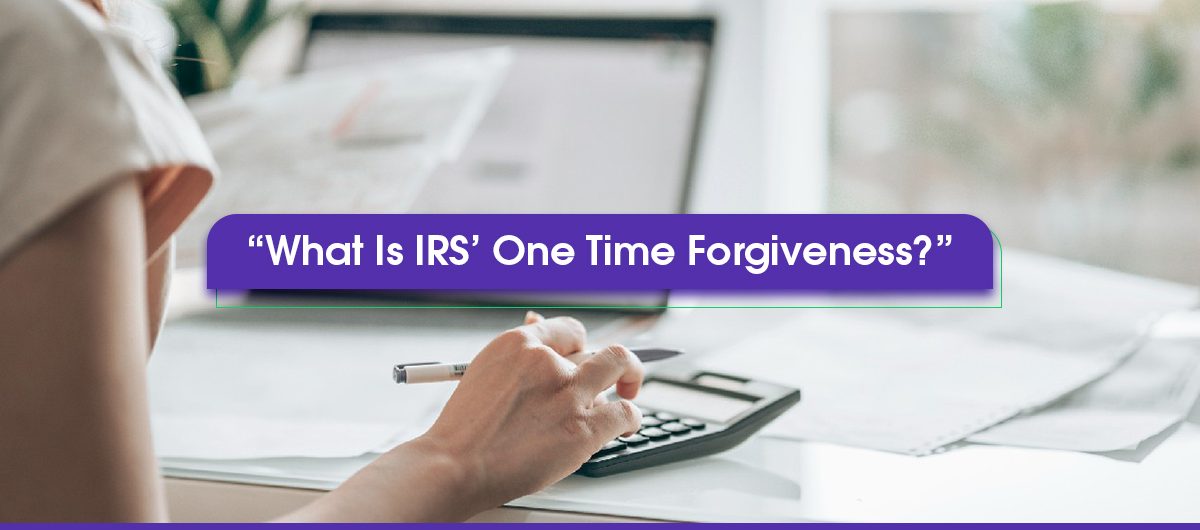What Is IRS One-Time Forgiveness?

Interim CFO Services For Proactive Business Choices
July 28, 2022
How To Create A Simple Bookkeeping Spreadsheet For Your Business?
August 3, 2022What Is IRS One-Time Forgiveness?
For one reason or another, there is a chance you may get hit with an unexpected tax penalty. Taxpayers often get penalized for falling behind on their taxes and failing to file or pay returns on time. Regardless of the cause, these penalties worsen your tax burden, and you ultimately have to pay more than you owe. However, if you know about IRS one-time forgiveness and qualify for it, you can evade some penalties.
The IRS is the world’s biggest tax collector agency but is not all evil. In reality, it is happy to work with you to help you relieve the tax stress. IRS doesn’t want you to enter a never-ending debt cycle that clutters your life and finances. However, the IRS has no other option than to penalize at times.
Get To Know IRS One-Time Forgiveness
According to Taxpayer Advocacy Panel’s 2020 report, the IRS issues 40 million penalties annually. There are about 150 different tax penalties. However, the common ones are failure to file, failure to pay, and failure to pay the owed amount from the previous tax year.
Fortunately, some options in our system, like IRS one-time forgiveness, help taxpayers reduce or even remove their penalties for a reasonable cause. Also referred to as penalty abatement, it saves taxpayers from paying the penalty for failing to file or pay income tax returns on time.
Businesses & individuals that qualify for this program can apply for one-time forgiveness by calling IRS or submitting IRS Form 843. However, the forgiveness is not for the ones with a bad record who habitually file or pay returns late. A taxpayer can receive IRS forgiveness in one of three ways:
– First-Time Tax Penalty Abatement
– Reasonable Cause
– Statutory Exception
3 Ways To Seek IRS One-Time Forgiveness
First-Time Penalty Abatement
The first-time penalty abatement helps businesses and individuals reduce or remove their tax fines. However, most people don’t know such a program exists. As it goes, only 12% of penalties got waived in 2019. Who qualifies for the first-time penalty abatement? Any business or individual that fulfills the following three criteria:
– The taxpayer has filed all their returns
– The taxpayer has paid the outstanding balance or planned installments with the IRS
– The taxpayer has no penalties in the last three years
It is essential to remember that the first-time penalty abatement only abates the penalty, not the tax liability. The interest associated with a failure-to-pay penalty continues to build up till the owed amount gets paid in full. However, it will get reduced or removed along with the linked penalty.
Check Out: Startup R&D Tax Credit: What You Need To Know
Reasonable Cause
Besides the first-time penalty abatement, you can also get one-time forgiveness for a reasonable cause. What is it? Here are some examples:
– A natural disaster, fire, or casualty
– Serious illness, death, or incapacitation of the taxpayer or close family
– Another reason that justifies your delay in filing/paying taxes
Unlike first-time penalty abatement, getting IRS forgiveness through a reasonable cause relies on facts. Your claim can never qualify unless you can back it up with solid documents and facts. To get one-time forgiveness from IRS for a reasonable cause, you need to share your story with the IRS.
Tell them about the actions and measures you took to file or pay returns on time and what prevented you from doing so. In addition, you will probably have to share some documents, like a letter from a physician in case of illness, documentation of a natural disaster, or other hospital or court records.
Statutory Exception
A statutory exception is perhaps the least common of the three, yet it still exists and can make a taxpayer eligible for one-time forgiveness. You are eligible to apply for it on the grounds of a statutory exception if you got a wrong written notice from the IRS.
To apply for a statutory exception, you need to file IRS Form 843 (Claim for Refund and Request for Abatement) and include a request for advice, the mistaken notice, and the amount you paid following it.
How to Apply for IRS One-Time Forgiveness?
Applying for the IRS one-time forgiveness is easy, and all you need to do is either call the IRS, submit IRS Form 843, or a written petition. If your penalty amount is relatively low, you can call and get it removed or reduced. However, it is better to write a letter to the IRS if the amount is high.
Either way, it is best to partner with a tax expert if you want to improve your odds of getting your penalty reduced or removed. In most cases, the cost of paying the tax expert to curtail your fee is lesser than the amount owed
See Also: 7 Best Tax Tips to Maximize Returns in 2022
Farwah Jafri
Farwah Jafri is a financial management expert and Product Owner at Monily, where she leads financial services for small and medium businesses. With over a decade of experience, including a directorial role at Arthur Lawrence UK Ltd., she specializes in bookkeeping, payroll, and financial analytics. Farwah holds an MBA from Alliance Manchester Business School and a BS in Computer Software Engineering. Based in Houston, Texas, she is dedicated to helping businesses better their financial operations.




